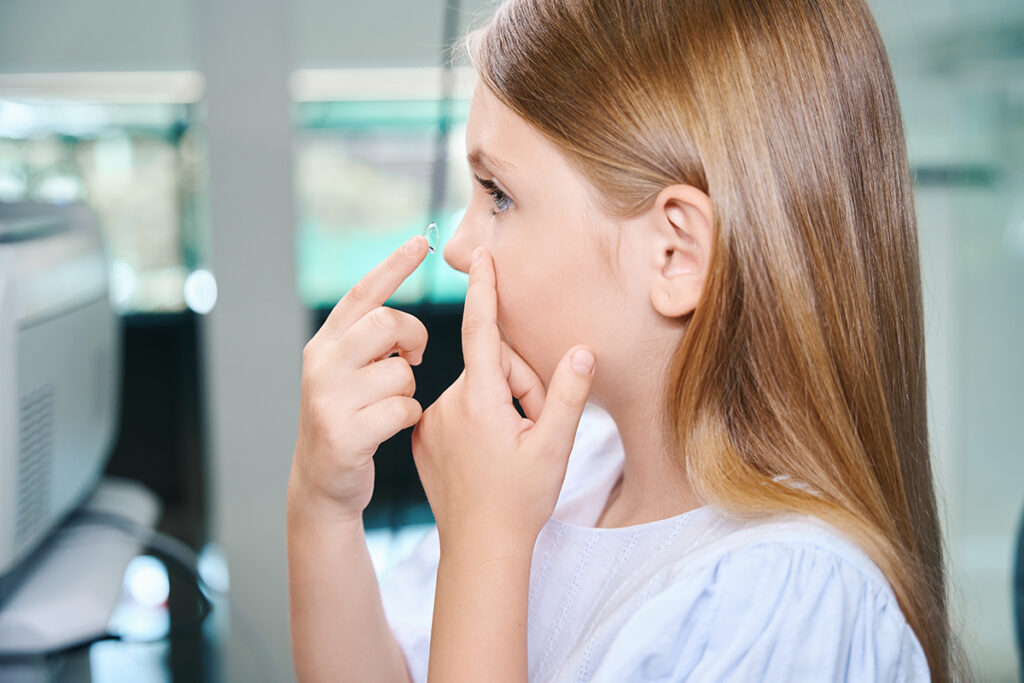As pediatric eye care professionals, we at Pediatric Eye Specialists understand the importance of providing your child with the best possible vision correction options. We recognize that the decision to pursue contact lenses for your child can be accompanied by a range of questions and concerns. That’s why we’ve created this comprehensive blog article to serve as a resource for parents seeking to understand the role contact lenses can play in their child’s visual health and development.

In this guide, we will draw upon our expertise to provide you with essential information about pediatric contact lenses. We’ll explore topics such as:
- The benefits of contact lenses for children
- The appropriate age to start wearing contact lenses
- The different types of contact lenses available
- Proper care and maintenance techniques
- Potential risks and how to mitigate them
Our aim is to empower you with the knowledge necessary to make informed decisions about your child’s eye care. We understand that every child is unique, and we are here to help you determine if contact lenses are the right choice for your child’s individual needs and lifestyle.
The Role of Contact Lenses in Enhancing Children’s Vision
The use of contact lenses in pediatric care is more than a corrective measure for poor vision; it’s a strategic approach to safeguarding your child’s eye health. Contact lenses for children are tailored not just to improve how they see the world, but also how they interact with it. These small but significant medical devices can be integral in correcting various vision disorders that, if left unaddressed, could affect a child’s developmental trajectory. They offer an alternative to glasses that some children may find more comfortable or suitable to their lifestyles, especially as they grow older. Through this introduction, we set the stage for a deeper exploration of the transformative impact contact lenses can have on a young person’s life.
Common Pediatric Eye Conditions That May Be Treated with Contact Lenses
Pediatric eye conditions can vary widely, but there are several for which contact lenses may be recommended as part of the treatment plan. Here’s a brief overview of common conditions:
Aphakia
Aphakia is the absence of the lens in the eye, usually resulting from cataract surgery or, very rarely, congenital factors. In children, the absence of the lens significantly affects the eye’s ability to focus light, leading to blurred vision. Special contact lenses for aphakia are designed to compensate for the missing natural lens. These lenses help focus light directly onto the retina, restoring clearer vision. The role of these contact lenses is vital since the natural lens plays a crucial role in focusing light in a healthy eye.
Refractive Errors
Refractive errors like myopia (nearsightedness), hyperopia (farsightedness), and astigmatism occur due to the irregular shape of the eye, which affects how light is bent or refracted within the eye. Contact lenses correct these errors by adjusting the path of light as it enters the eye to ensure it focuses directly on the retina. For myopia, contact lenses help in focusing the light further back in the eye, while for hyperopia, they help focus it more forward. In astigmatism, where the eye has an irregular curvature, specially designed toric contact lenses are used to provide different refractive powers at different parts of the lens to correct the uneven refraction.
Amblyopia (Lazy Eye)
Amblyopia, commonly known as lazy eye, is a condition in which one eye has decreased vision due to abnormal visual development early in life. Contact lenses can be part of the treatment for amblyopia, especially when the condition is caused by a significant difference in the refractive error between the two eyes. Contact lenses can correct this imbalance, ensuring each eye receives clear images. This correction is crucial for brain-eye coordination and can prevent the weaker eye from being ignored by the brain.
Post-Surgical Correction
Contact lenses might be necessary for vision correction or therapeutic purposes after certain eye surgeries like congenital glaucoma, trauma, or after pediatric cataract surgery. In these cases, contact lenses can play a crucial role in vision rehabilitation by providing the necessary optical correction or protecting the eye during the healing process. The specific type of contact lens used will depend on the child’s individual needs and the nature of their surgical treatment.
In all these conditions, contact lenses provide more focused and clearer vision, which is crucial for children’s normal visual development. Parents should work closely with Pediatric Eye Specialists to determine the best type of contact lens for their child’s specific condition.

Types of Pediatric Contact Lenses
Selecting the right type of contact lenses for your child is crucial for their comfort and eye health. Here’s a breakdown of the options:
Soft Lenses
These are the most common type of contact lenses. Made from soft, flexible plastics that allow oxygen to pass through to the cornea, they are generally comfortable and easier for children to adapt to. Soft lenses can be used for daily wear or extended wear.
- Pros:
- Comfort: Soft lenses are made from flexible materials that conform to the eye, making them comfortable and easy to adapt to, especially for children.
- Oxygen Permeability: These lenses allow significant oxygen flow to the cornea, which is crucial for eye health.
- Variety of Uses: Suitable for both daily and extended wear, providing flexibility in lens-wearing schedules.
- Cons:
- Durability: Soft lenses are more prone to tearing and damage compared to other types.
- Protein Deposits: They can accumulate proteins and lipids from the tear film more easily, requiring diligent cleaning.
- Less Precision: May not offer as sharp vision correction as RGP lenses, especially for higher prescriptions or complex eye conditions.
Rigid Gas Permeable (RGP) Lenses
RGP lenses are more durable than soft lenses and in some cases offer clearer, crisper vision correction. They are less likely to harbor bacteria than soft lenses, making them a good option for children with certain corneal issues or higher prescriptions. They can take some time to get used to, but they are beneficial for long-term eye health.
- Pros:
- Clear Vision: RGP lenses provide crisp and clear vision correction, beneficial for children with significant refractive errors.
- Durability: More durable and resistant to buildup than soft lenses.
- Eye Health: They are less likely to harbor bacteria, reducing the risk of eye infections.
- Cons:
- Adjustment Period: It can take longer for children to get used to the feel of RGP lenses.
- Discomfort: Initially, they might be less comfortable than soft lenses.
- Handling: Due to their smaller size and rigidity, they can be more challenging for children to handle and care for.
Hybrid Lenses
These lenses feature a rigid gas permeable center surrounded by a soft lens skirt. They offer the clarity of RGP lenses with the comfort of soft lenses and can be a suitable option for children needing vision correction for conditions like keratoconus or irregular astigmatism.
- Pros:
- Best of Both Worlds: Combines the comfort of soft lenses with the clear vision of RGP lenses.
- Suitable for Special Conditions: Excellent for children with keratoconus or irregular astigmatism where precise vision correction is needed without compromising comfort.
- Stability: The rigid center ensures stable vision correction, while the soft skirt reduces the risk of the lens dislodging.
- Cons:
- Cost and Availability: Tend to be more expensive and not as widely available as soft or RGP lenses.
- Care and Maintenance: Require careful handling and regular cleaning like RGP lenses.
- Adjustment Period: Some children may take time to adjust to the feeling of hybrid lenses due to the presence of both rigid and soft components.
Each type of contact lens has its unique advantages and challenges. The choice should be based on the child’s specific vision needs, lifestyle, and ability to handle and care for lenses. It’s essential to consult with Pediatric Eye Specialists to determine the most suitable option for your child.
Choosing the Right Lens Design and Fit
The right lens design and fit are vital for ensuring that your child has a positive experience with contact lenses. Here are some considerations:
- Custom Fit: Children’s eyes are unique, and a professional fitting is essential. Pediatric Eye Specialists uses tools like corneal topography to map the eye’s surface and design lenses that fit perfectly.
- Lens Design: The design of the lens will depend on the specific vision correction needs of your child. As an example, Toric lenses are designed for correcting astigmatism.
- Material: The material of the lens affects oxygen permeability, hydration, and overall comfort. Pediatric Eye Specialists will recommend the best material based on your child’s needs and wearing pattern.
Myopia-Control Contact Lenses
Myopia is also known as nearsightedness. It means your child can see thing near clearly, but distant objects are a challenge to see. Advancements in contact lens technology have led to the development of specialized myopia-control lenses designed to slow the progression of nearsightedness in children.
Types of Myopia-Control Lenses:
- Orthokeratology (Ortho-K) Lenses: Worn overnight, these lenses gently reshape the cornea to correct myopia temporarily, with the added benefit of slowing its progression.
- Multifocal Contact Lenses: These lenses have different powers in different zones. They are designed to correct nearsightedness and, at the same time, reduce the eye’s focusing effort, which can help control myopia.
- Dual-Focus Contact Lenses: These are similar to multifocal lenses but specifically designed to reduce the progression of myopia. They focus light differently on the peripheral retina, which is believed to signal the eye to grow less elongated and thus slow down myopia progression.
Practical Aspects of Pediatric Contact Lens Use
The success of contact lens use in children heavily relies on proper lens care and compliance with prescribed wearing schedules. Here’s how to guide children in the process:
- Routine Establishment: Create a daily routine for lens care and make it a habit, much like brushing teeth.
- Hygiene Practices: Emphasize the importance of hand washing before handling contact lenses.
- Proper Usage: Teach children how to put in and take out lenses safely, and how to recognize if a lens is inside out.
- Lens Maintenance: Show them how to clean and rinse lenses using appropriate solutions, and how to properly store them.
Even with the best practices, issues may arise. Being prepared to address common problems can ensure continuous and comfortable lens wear:
- Discomfort: If lenses cause discomfort, ensure they’re clean, undamaged, and not inverted. If discomfort persists, remove the lens and consult Pediatric Eye Specialists.
- Red Eye: Should the eyes become red or painful with lens wear, cease use immediately and seek professional advice, as this could be a sign of infection.
- Loss or Damage: Teach children to handle lenses over a clean surface to avoid dropping them. If a lens is lost or damaged, replace it and have a spare pair available.
Parents play an indispensable role in ensuring the safe and effective use of contact lenses by their children:
- Supervision: Especially for younger children, supervise the application and removal of lenses until they become proficient.
- Education: Continually educate children about the risks associated with improper lens use, such as sharing lenses or wearing them for too long.
- Support: Be supportive and patient as children learn to manage their lens wear, and be their advocate in maintaining regular appointments with their eye care provider.
By taking an active role in educating and supporting their children’s contact lens use, parents can help minimize risks and ensure a positive experience, leading to a successful adaptation to contact lenses as a normal part of their children’s lives.
Safety Considerations for Pediatric Contact Lens Wear
Safety is paramount when it comes to contact lenses for children. Here’s what to keep in mind:
- Hygiene: Teach your child the importance of handwashing before handling lenses and following the cleaning instructions provided by your eye care provider.
- Regular Checkups: Frequent eye exams ensure that the lenses are still fitting well and not causing any harm to your child’s eyes.
- Monitoring: Parents should monitor their child’s lens wear and eye health, watching for signs of discomfort, redness, or infection.
- Education: Educate your child on the importance of not sharing lenses, avoiding water while wearing lenses, and understanding when to dispose of their lenses.
By considering these factors and working closely with Pediatric Eye Specialists, you can help ensure that your child’s experience with contact lenses is safe and beneficial for their vision and lifestyle.
Schedule Your Child’s Consultation Today
If your child is experiencing visual issues that may require specialized contact lens fittings, schedule a consultation with Pediatric Eye Specialists. Their team of experts is expertly equipped to handle a wide range of pediatric eye conditions and can offer personalized solutions that cater to your child’s unique needs. Whether it’s for correcting refractive errors, managing conditions like aphakia or amblyopia, or even exploring innovative options like orthokeratology, Pediatric Eye Specialists has the expertise to ensure your child receives the best possible care.
Taking this step can be crucial in not only improving your child’s vision but also in enhancing their overall quality of life. A professional consultation will provide you with a clear understanding of the options available and the best course of action for your child’s eye health.
Schedule Your Child’s Appointment Today
More FAQs about Pediatric Contact Lenses
What age is appropriate for a child to start wearing contact lenses?
This varies depending on the child’s maturity, responsibility level, and specific eye condition. Some children can start as young as eight years old.
Can contact lenses help slow the progression of my child’s myopia?
Yes, certain types of contact lenses, like orthokeratology lenses, have been shown to slow myopia progression in children.
Are contact lenses safe for children to use?
Yes, when used properly and with good hygiene practices, contact lenses are safe for children.
How long does it typically take for a child to adjust to wearing contact lenses?
The adjustment period varies but typically ranges from a few days to a couple of weeks.
Will my child need to avoid certain activities or sports when wearing contact lenses?
In most cases, contact lenses allow children to participate more freely in sports and activities, though precautions should be taken for water sports or in dusty environments.
How do I know if my child is ready to handle the responsibility of contact lenses?
Assess if your child is diligent with personal hygiene, follows instructions well, and shows interest in taking care of lenses.
What are the signs that my child might be having issues with their contact lenses?
Signs include eye redness, irritation, prolonged discomfort, or a noticeable decrease in visual perception.
Can my child sleep in their contact lenses?
Most contact lenses should not be worn overnight, except specific extended wear lenses prescribed by an eye care professional.
How often will my child’s contact lenses need to be replaced?
Replacement schedules vary depending on the type of lens, ranging from daily disposables to monthly or quarterly replacements.
What should I do if my child develops an eye infection from contact lens wear?
If you suspect an infection, discontinue lens use immediately and consult your child’s eye care provider as soon as possible.
Dr. Eric A. Packwood is a Partner at Pediatric Eye Specialists, President of the Child Vision Center, and the Administrative Director of Ophthalmology at Cook Children’s Medical Center. He graduated from Rice University and Baylor College of Medicine, and completed his ophthalmology residency at St. Louis University as chief resident, followed by a fellowship at Washington University.
Since moving to Fort Worth in 2000, Dr. Packwood has been recognized as a “Super Doctor” by Texas Monthly, a “Best Doctor for Your Child” by D Magazine, and a “Top Doc” by Fort Worth, Texas magazine. He volunteers at the Alexander Eye Clinic and is involved in medical mission work for underprivileged children. Dr. Packwood has also published several peer-reviewed articles and participated in multiple clinical trials.
